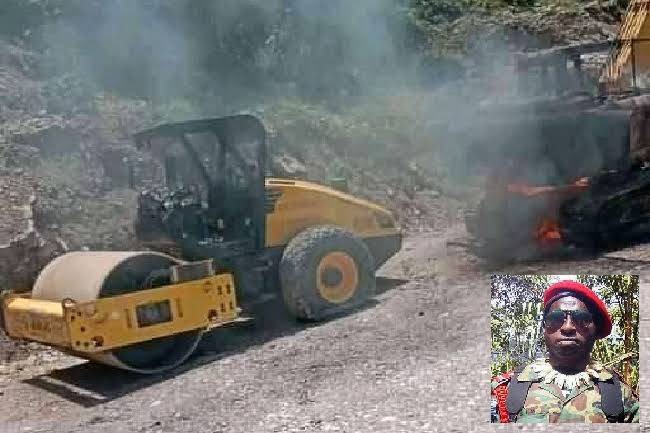by Solidarity for Indigenous Papuans
Conflict Background in Oksibil
The armed conflict in Oksibil area is the continuation of the struggle for West Papua freedom started in the 1960s and maintained by West Papua people under Organisasi Papua Merdeka (OPM) Free Papua Movement up to date. Oksibil conflict cannot be minimized down to view the conflict from a single spot; it has to be looked at from the whole West Papua conflict being maintained in several regencies within West Papua. The OPM has its military wing, the West Papua National Liberation (WPNLA/TPNPB-OPM) which has 33 command posts throughout the region aspire to maintain the armed struggle in every part of West Papua. The Ngalum-Kupel Comand is the 15th Command post under the leadership of General Alipki Lamek Taplo based in Oksibil.
The Star Mountain people were the latest contacted people by the Netherlands Government in 1959. The short contact did not last long because Indonesia had to take over the territory by 1963. In 1969 act of free choice, the representatives from Oksibil protested strongly in Wamena resulted in their leader Katkotweng Uropkulin excluded from participation in the vote. He was locked up in a confined room until the whole process was completed. He was released later and returned to Oksibil where he helped organized the resistance movement in the community.
In the 1970s his son Karel Uropkulin took over the leadership and led most of the people into the jungles between Papua New Guinea and West Papua maintaining the freedom struggle. Some went to live in refugee camps in Papua New Guinea while others maintained their positions in the jungles and fight Indonesian military with bows and arrows. The people of Oksibil still maintained their position to date because Indonesia does not want to resolve the conflict peacefully. Stories from other places are similar to what is happening in Oksibil, Indonesia does not have a formula to address the conflict in West Papua in general. The armed conflict is likely to continue as long as Indonesia is in West Papua.
Existing Politically charged groups in Oksibil
The existing pro-independence groups in Oksibil reflect the general situation in Papua. Groups include West Papua National Committee (KNPB), West Papua Interest Association Group (WPIA), and Organisasi Papua Merdeka (OPM) group. United Liberation Movement for West Papua group is establishing their residency in the regency in 2020, not many members in this group. Most of these groups are advocating for independence through peaceful means except for OPM. The OPM has many sympathisers and emphasis is often placed on armed struggle.
On the other hand, the Indonesians set-up proxy groups and spy networks in Oksibil which include the Barisan Merah Putih (Red and White Group), Soranda group, KNPI (Indonesian youth wing) and the descendants of voters in the act of free choice. They set up spy network from Oksibil into outer districts. Most of them posted as teachers and health workers. The established narratives in the local community led to the current destruction of health and education facilities in the Kiwirok district.

Capture of two WPNLA members in District Batom Star Mountain Regency
On the 6th of September 2021, two members of TPNPB-OPM were captured in Batom District assisted by the members of Soranda Group and local government officials. The two members have five firearms including live bullets bought in Papua New Guinea. They were crossing the border along the head waters of the Sepik River near Green River district of Papua New Guinea when the local people (members of Soranda group) spotted them and reported to the Indonesian military base in district Batom.
It was the first time that the OPM bought firearms from Papua New Guinea and the OPM leaders expected the local people to keep quiet but the local people sided with the Indonesians. The OPM leaders have vowed to kill whoever is on the side of Indonesian military including the civilians both local and migrants. The capture of the two members of OPM-TPNPB was due to the local people’s involvement in the spy network of Indonesia. That is the reason behind the destruction of public facilities in Kiwirok and also set fire to the heavy equipment in district Oksop. To make the people feel the effect of what it takes to lose something you fought hard to acquire. It is sort of revenge by the OPM which the conflict is likely to continue because all the politically charged groups are somehow interconnected within the conflict.


Special Autonomy and Development: OPM’s point of view
Anything that smells like the expired Special Autonomy Policy reminds West Papuans of the past 20 years of misery. They do not want to entertain any of it after the expiration date. Indonesian government extended the special autonomy without consulting the Papuans on 15th July 2021 in the Indonesian Parliament. West Papuans have rejected it and have been expecting changes but no changes are coming their way.
The OPM under the leadership of Lamek Taplo has published an ultimatum recently that they will burn the development facilities of the Indonesian government under the Special Autonomy policy. They also warned immigrants to move out of conflict zones, any of them found in the conflict zone is considered as spies. Following the announcement, the OPM first burned the machines in district Oksop and later into Kiwirok district. Most of the stories with regard to destruction of properties and public facilities are found in the Indonesian media.



West Papua National Liberation Army’s position on the armed conflict
The WPNLA’s position has been that war against the Indonesian government will be there until Indonesia withdraws entirely from West Papua. In a recently released statement, they stated that; “the fight has historical significance based on United Nations Resolution 1514 of 14th December 1960 on the granting of independence to colonial peoples and territories and its subsequent resolutions. West Papua still remains to be the unfinished business of United Nations Decolonisation program of the 1960s of which the fight to reclaim that freedom is justified under the International Law.
The OPM is open to negotiate with Indonesia to resolve the conflict peacefully, but it has to be mediated by an international neutral third party. The Indonesian concept of national dialogue and peace negotiation simply cannot work; West Papuans have grown thick skins to Indonesians mistreatments with regard to the subject of peace negotiations.
Indonesian Government’s Official Position on the armed Conflict
The Indonesian government maintained their position throughout the conflict that there is no war or armed conflict in West Papua, the government has been engaging in a law enforcement program (peneggagkan hukum) to apprehend the armed criminal groups that killed the health workers and destroyed road construction equipment and other facilities to be brought to justice. The government termed the operation as “Operasi kemanusiaan”/Humanitarian Operation to serve those people who are terrorised by the armed criminal groups. This position has been maintained since 2018.
They claimed that Police are doing their job and military is assisting the police to keep the law and order in Papua region. They simply brush aside any talk of peace with the so called armed criminal groups in Papua. They aspire to crush the armed criminal groups militarily and achieve peace in Papua. The Indonesian government has recently categorized OPM as a terrorist organization aspires to force neighbouring countries and the UN to follow suit.
For the traumatised civilians in Papua, Indonesian government devised what they called “wining heart and mind strategy” to calm the Papuan public, discourage them to join the OPM or even assist them to fight against Indonesia. Military in schools, churches including the so called ‘trans-Papua road project and the extension of the Special Autonomy package is part of the strategy. The government interpret the conflict in Papua from the development aspect which is far away from addressing the conflict.
Active conflicts elsewhere in West Papua
The armed conflict is still active in Yahukimo, Puncak, Nduga, Intan Jaya and current eruption in Maybrat regency in the bird’s head region of the island (see attached brief report). We also have other existing environmental destruction in Timika and Merauke regencies (see report attached).
The Special Autonomy issue is still active and Papuans are expected to do demonstration against the policy throughout major towns in Papua .
Indonesian Government’s methods of resolving the conflict
Indonesian government has always been reluctant to resolve the conflict; its actions are conducted in such a way that conflict in Papua has to be maintained and resources are exploited cheaply. Indonesia has been applying Band-Aid strategy narrowing conflict down to specific conflict spots and send in military to apply scotch-earth strategy to wipe out the population in the identified area. The strategy is keeping the conflict going throughout Papua because; it has displaced thousands of people and destroyed homes and properties worth millions.
Appeal to the international community
West Papuans are really dying; they need assistance from the international community. The conflict will last for ages here in West Papua as long as Indonesia is in West Papua. We are appealing to the international community to put pressure on the governments and international organizations to urge Indonesia to resolve the conflict through peaceful means. The Pacific Islands Forum Leaders (PIF) and Africa, Caribbean and Pacific (ACP) leaders have been addressing the issue. We hope that the international community put their respective governments on notice to respond to West Papua conflict based on the principle of Responsibility to Protect.






